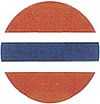Fatherland League (Norway)
| Fatherland League | |
|---|---|
 | |
| Chairman |
Joakim Lehmkuhl (1925–1938) Victor Mogens (1938–1940) |
| Founded | 25 January 1925 |
| Dissolved | 25 September 1940 |
| Succeeded by | None; banned by German occupying forces |
| Newspaper | ABC |
| Ideology |
Conservatism National conservatism Nationalism Monarchism Anti-communism |
| Political position | Right-wing |
| Colors | red, white, blue (Norwegian colors) |
|
Politics of Norway Political parties Elections | |
The Fatherland League (Norwegian: Fedrelandslaget) was a political organisation in Norway, which was founded on 25 January 1925. By the initiative of young industrialist Joakim Lehmkuhl, the organisation was co-founded with polar explorer Fridtjof Nansen and former Prime Minister Christian Michelsen.[1] The goal of the organisation was to lay the groundwork for a national coalition policy, by gathering all non-socialist ("borgerlige") and nationally minded forces,[2] in opposition to the emerging Marxist and socialist Labour movement.[1][3] In 1930, the organisation had about 100,000 members and more than 400 local chapters.[3][4] In the late 1930s the Fatherland League became an official political party in Norway.[5] The organisation, like all other parties but the Nasjonal Samling, was forcibly dissolved by Reichskommissar Josef Terboven on 25 September 1940, during the Occupation of Norway by Nazi Germany.[1][3]
From 1932, the main organ of the organisation was the weekly magazine ABC. The party gained particular support from the liberal conservative Liberal Left Party (later Liberal People's Party) and the Farmers' Party, while it was met with scepticism by the Conservative Party and rejection by the Liberal Party. The Labour movement in turn claimed that the organisation functioned as a seeding ground for a fascist movement.[1] The organisation was highly active during the 1930 and 1933 parliamentary elections.[1][3] For the 1936 parliamentary election the organisation ran lists in a few districts, both independently and together with the Liberal People's Party. During the 1930s, the movement came under the influence of Italian Fascism and German National Socialism.[2] The organisation declined in the late 1930s, partly due to a moderation in the ideology of the Labour Party, and partly as an effect of the Nazi-German friendly attitude exhibited by many of its leaders.[1] After the German invasion in Norway on 9 April 1940, the League tried to establish a political alternative to the Quisling regime. However, chairman Victor Mogens' secret talks and negotiations in Summer 1940 remained eventually unsuccessful.[2]
References
- ↑ 1.0 1.1 1.2 1.3 1.4 1.5 "Fedrelandslaget". Store norske leksikon (in Norwegian). Retrieved 26 February 2011.
- ↑ 2.0 2.1 2.2 Sørensen, Øystein (1995), "Fedrelandslaget", Norsk krigsleksikon 1940-45 (in Norwegian)
- ↑ 3.0 3.1 3.2 3.3 "Fedrelandslaget". Caplex (in Norwegian). Retrieved 26 February 2011.
- ↑ Friis, Jacob; Hegna, Trond, ed. (1933). "Fedrelandslaget". Arbeidernes Leksikon (in Norwegian) 2. Oslo: Arbeidermagasinets forlag.
- ↑ "Fedrelandslaget", NRK (in Norwegian)
|first1=missing|last1=in Authors list (help)